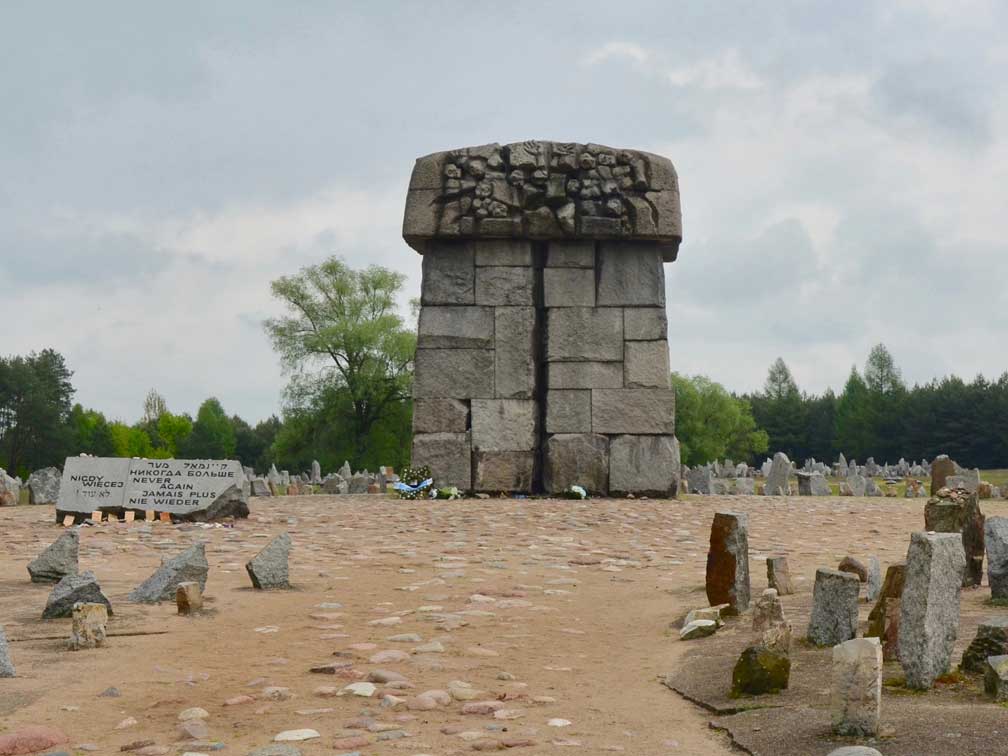July 23, 1942 Treblinka begins gassing operations

Memorial at Treblinka today
Treblinka which was set up as a death camp for Polish Jews primarily from the Warsaw area. On July 23 the SS began gassing those arriving at the camp..
Treblinka was one of the three death camps that were part of "Operation Reinhard".
It was built as the place of execution for the Jews of the Warsaw Ghetto and its surroundings. It was located near Malkinia, about 80 kilometers north-east of Warsaw. Malkinia was a station on the main Warsaw-Bialystok railroad line in a densely populated area and hidden among deep woods. Jewish and Polish prisoners worked in a punishment camp called Treblinka 1 built as early as 1941. When the extermination camp was built in 1942, the railroad line was extended into it.
“Operation Reinhard" was the code name for “the final solution to the Jewish question” (the extermination of all the Jews) in the areas in Poland under the jurisdiction of the General Gouvernment in the Belzec, Sobibor and Treblinka camps. Several months after work began, the name was suggested in memory of Reinhard Heydrich, head of the SD (The Security Police of the SS) and one of the architects of the "final solution to the Jewish question", who was shot to death by Czech Underground fighters in May of 1942.
The camp was built in the shape of a polygon, 400 x 600 meters. It had a double barbed wire fence. The inner fence was entwined with branches designed to hide the camp and what was happening there. There were 8 meter high guard towers in each corner and all along the fences. It was divided into three areas:
The living quarters which included those of the staff (Germans and Ukrainians), offices, the infirmary, storage buildings and workshops. A separate fenced-in area housed the Jewish prisoners' barracks, sewing shops, a shoemaker and a carpentry shop.
The reception area included the train platform and tracks for shipments, two huts in a fenced-in area where the victims were ordered to undress, and two buildings where the victims' possessions were kept and sorted.
The extermination area (the upper camp) was small, only 200 x 250 meters, with a white building which held three gas chambers. There was a diesel motor housed in a building nearby. The victims were executed by carbon monoxide gas that was forced into the chambers through a pipe connected to the roof and into regular shower heads, in order to sustain the illusion of a real shower.
One hundred and fifty yards away to the east, were large pits for burying the victims.
Between the "reception area" and the "extermination area" there was a narrow path surrounded by wire and intertwined with branches, called "the Pipe," or "The Way to Heaven", used by the staff and prisoners ("Himmelfahrtstrasse") [Map K-7]. The naked victims were led along here from the undressing huts into the gas chambers.
There were 20-30 SS guards in positions of command and organization and about 90-120 Ukrainians. These were Soviet prisoners of war who volunteered to serve the Germans. They acted as guards and assisted in operating the gas chambers.
The 700-1,000 Jewish prisoners did all the work in the camp. They were divided into work groups or "Kommandos". The uniforms of each Kommando unit had a stripe of a designated color which distinguished them from one another.
The exterminations began on July 23, 1942 and continued until April 1943.
From the spring of 1943 only a few transports arrived and then began the burning of the bodies that had been buried in mass graves.
Hundreds tried to escape from the trains, most of whom were murdered by the guards. In the early years, before stringent guarding arrangements were established, a few Jews managed to escape from the camp. From time to time there were incidents of Jewish uprisings and from early 1943, an underground existed comprised of prisoners from all parts of the camp. There was an uprising on August 2,1943, when the last of the bodies had been burned and the camp destroyed, indicating that soon the remaining prisoners would be executed.
During the uprising most of the camp burned. The remaining prisoners were ordered to take the buildings and fences apart and try to erase signs of the crimes committed there. When the work was done, everyone was shot. The camp was plowed over, and trees were planted. A farm was established and Ukrainians settled there.
About 70 of those who managed to escape from the camp during the uprising survived until the end of the war. 800,000 people were murdered at Treblinka; 2000 of them were Gypsies and most of the rest were Jews. The Jews came from Warsaw, Bialystok, Grodno, Radom, Czenstochowa and even Lublin.
Jews from Theresienstadt, from Thrace, which became part of Bulgaria, Greece and Jugoslavian Macedonia were also executed there.
As the Red Army approached, even the farm that had been established on the camp site was plowed over.
Over 900,000 people almost all Jews were killed at Treblinka
 >
>